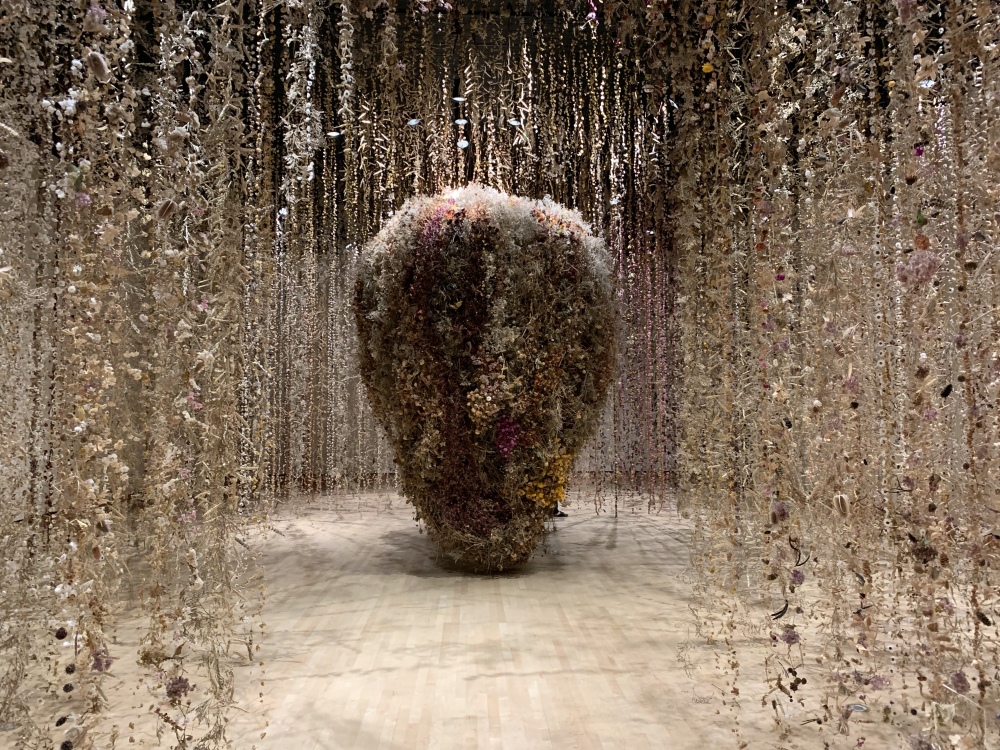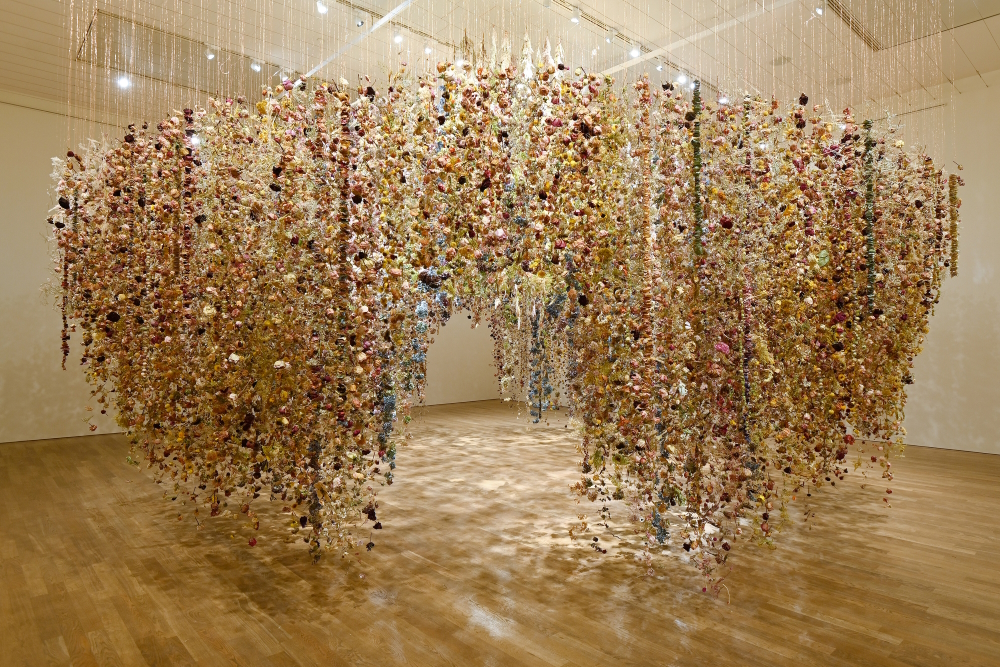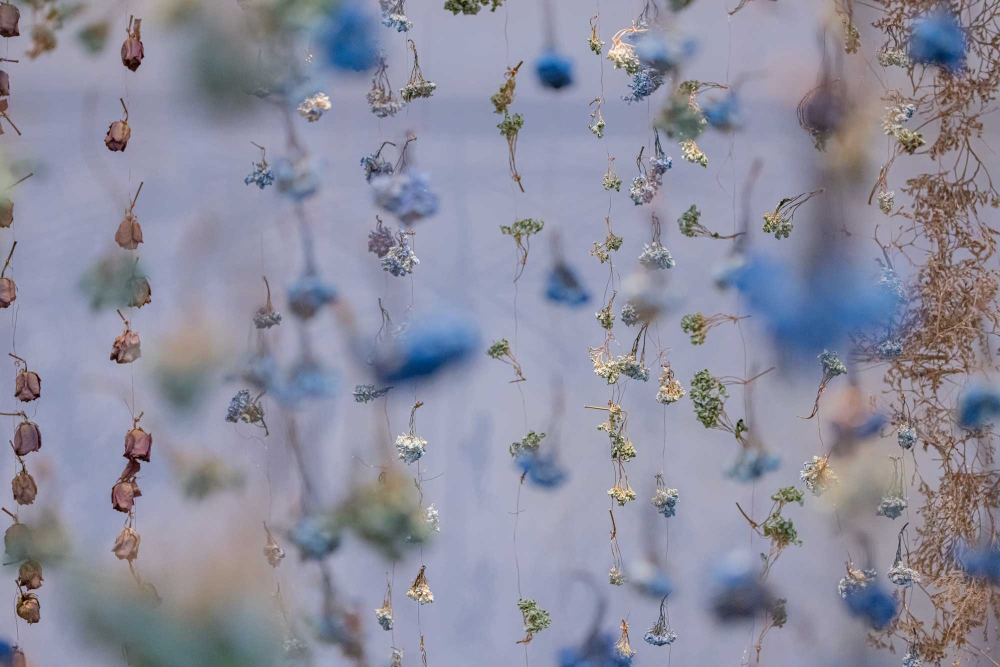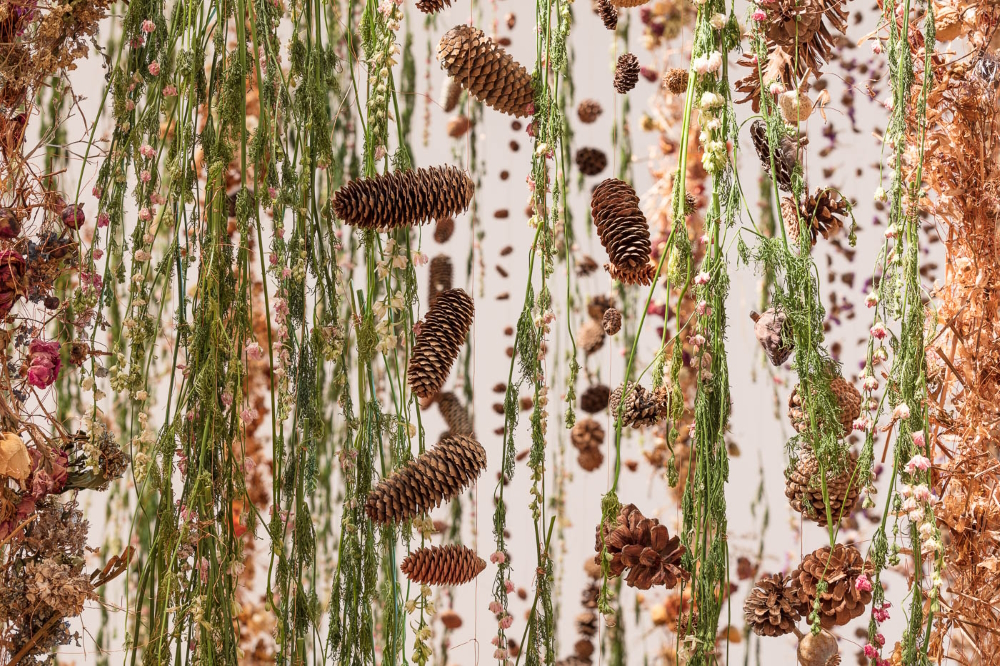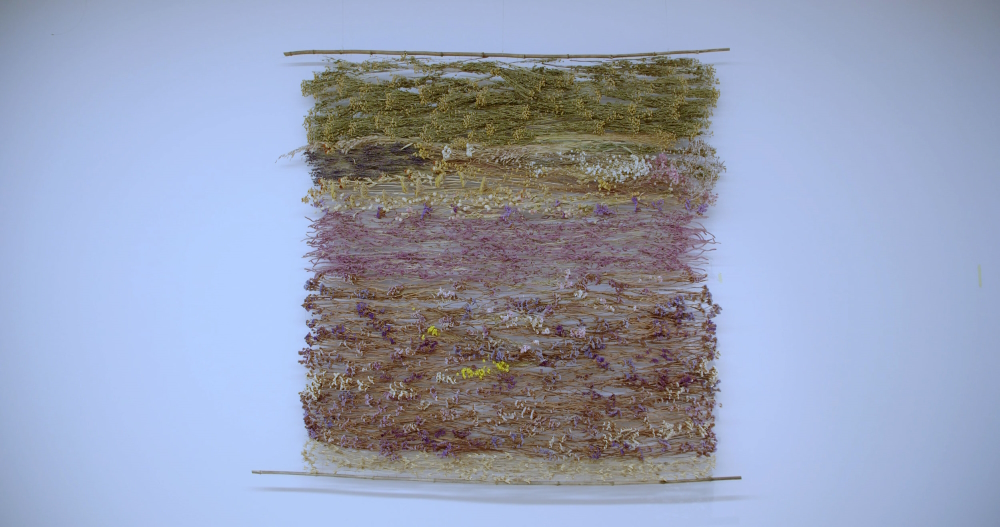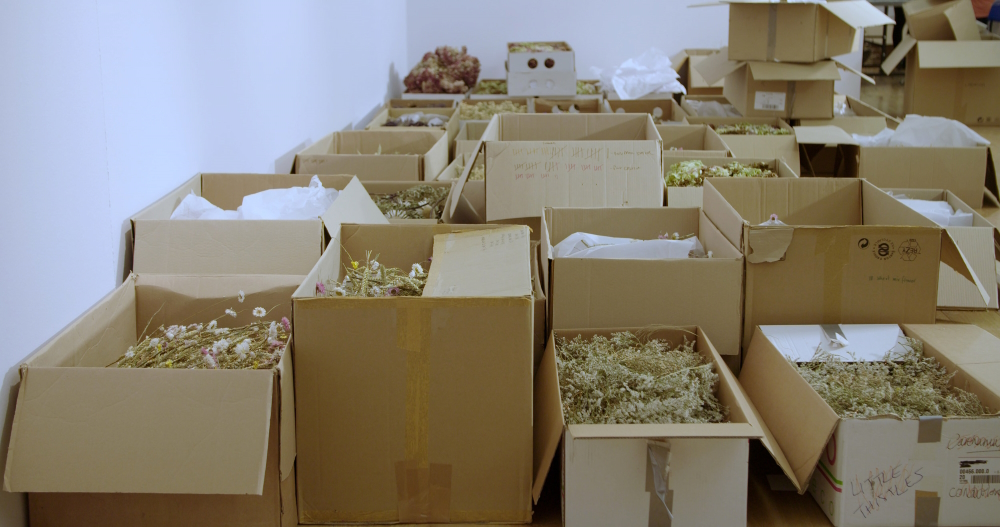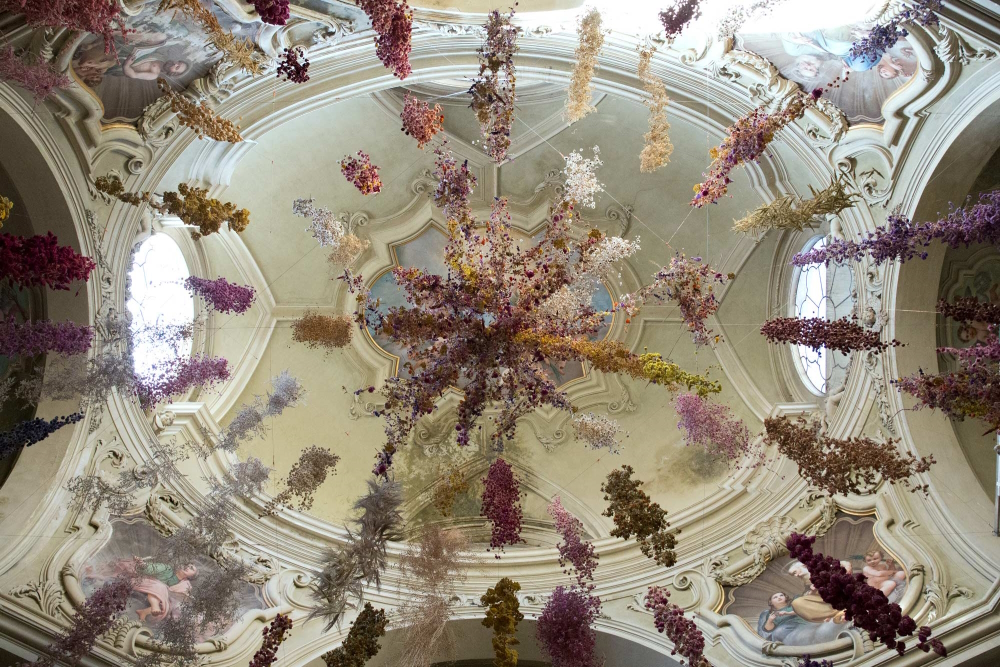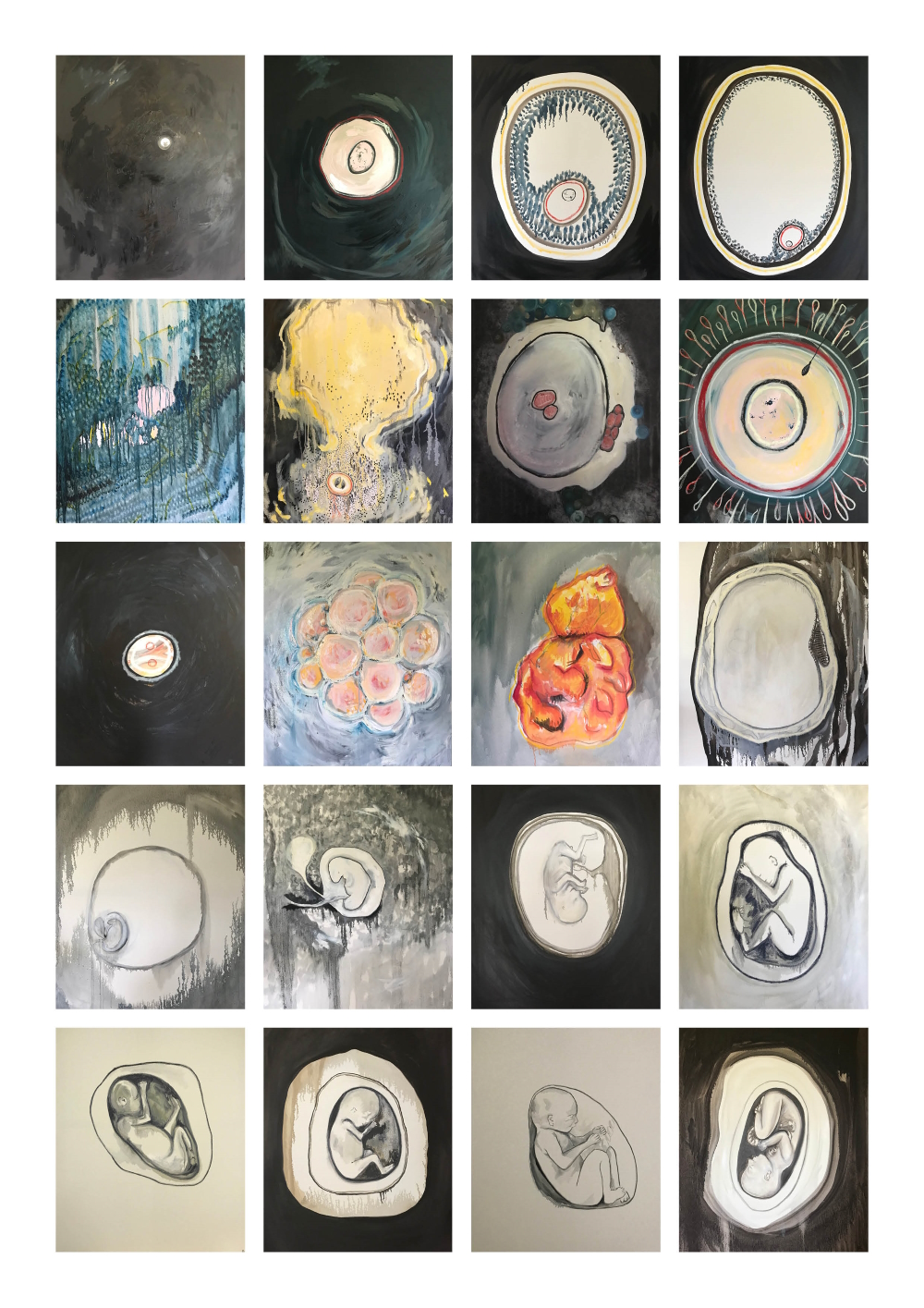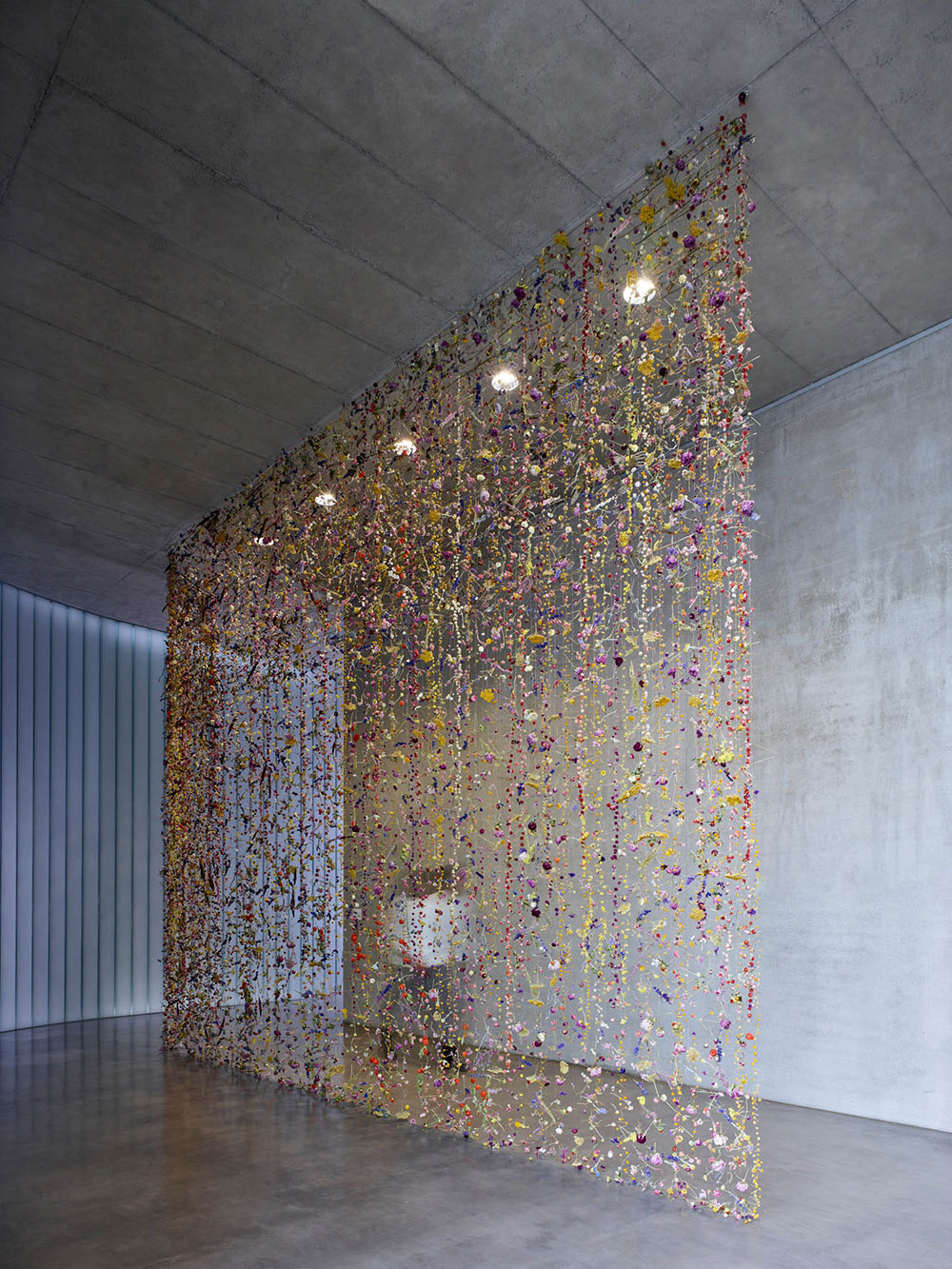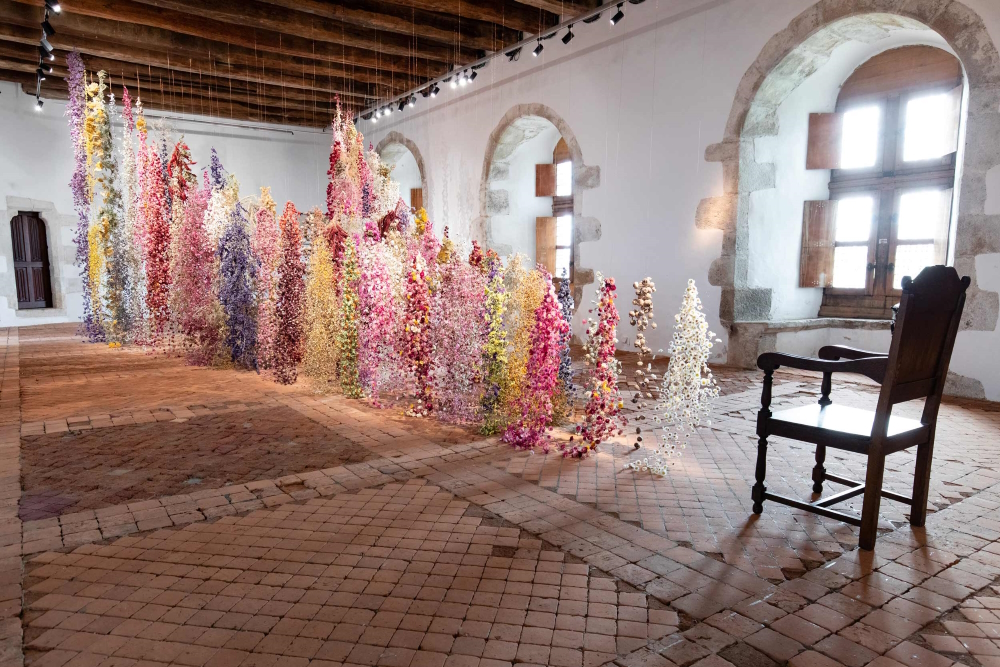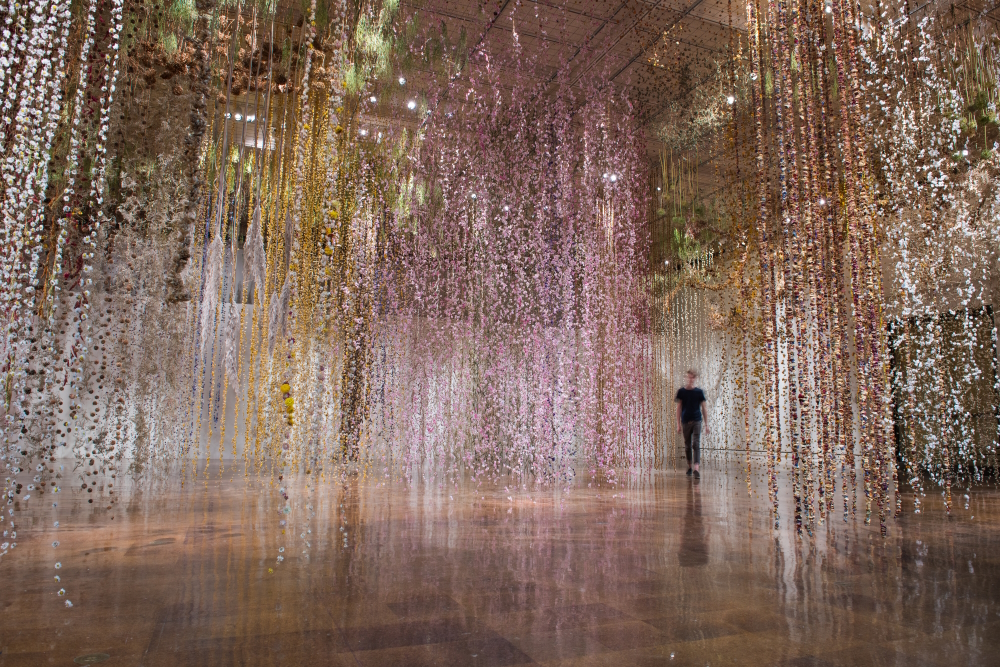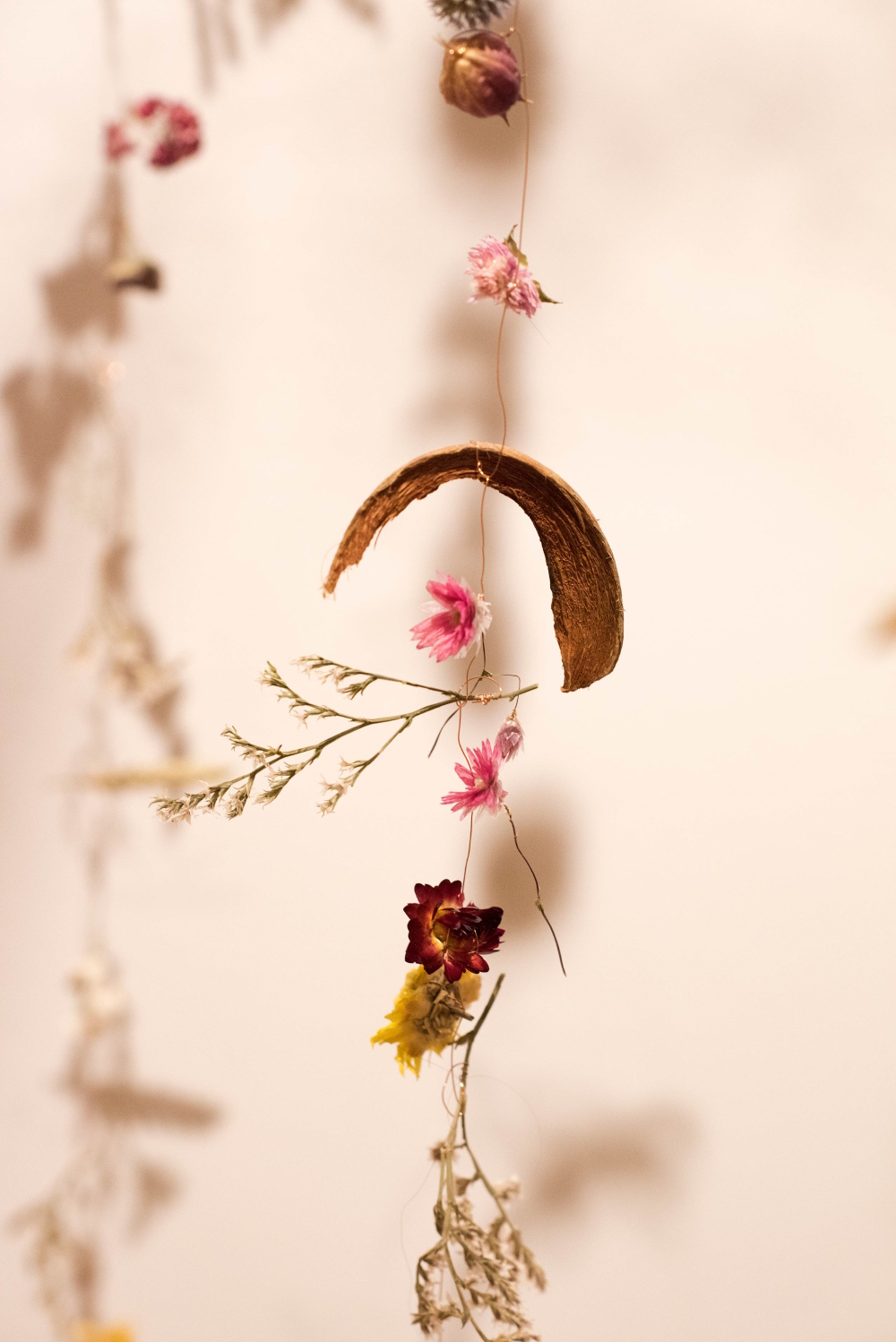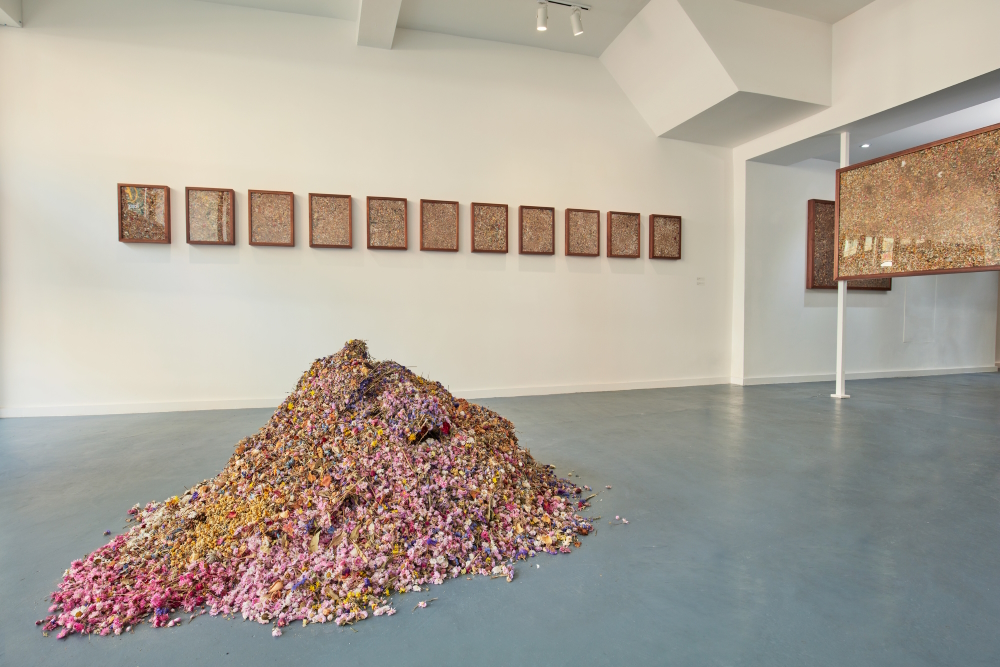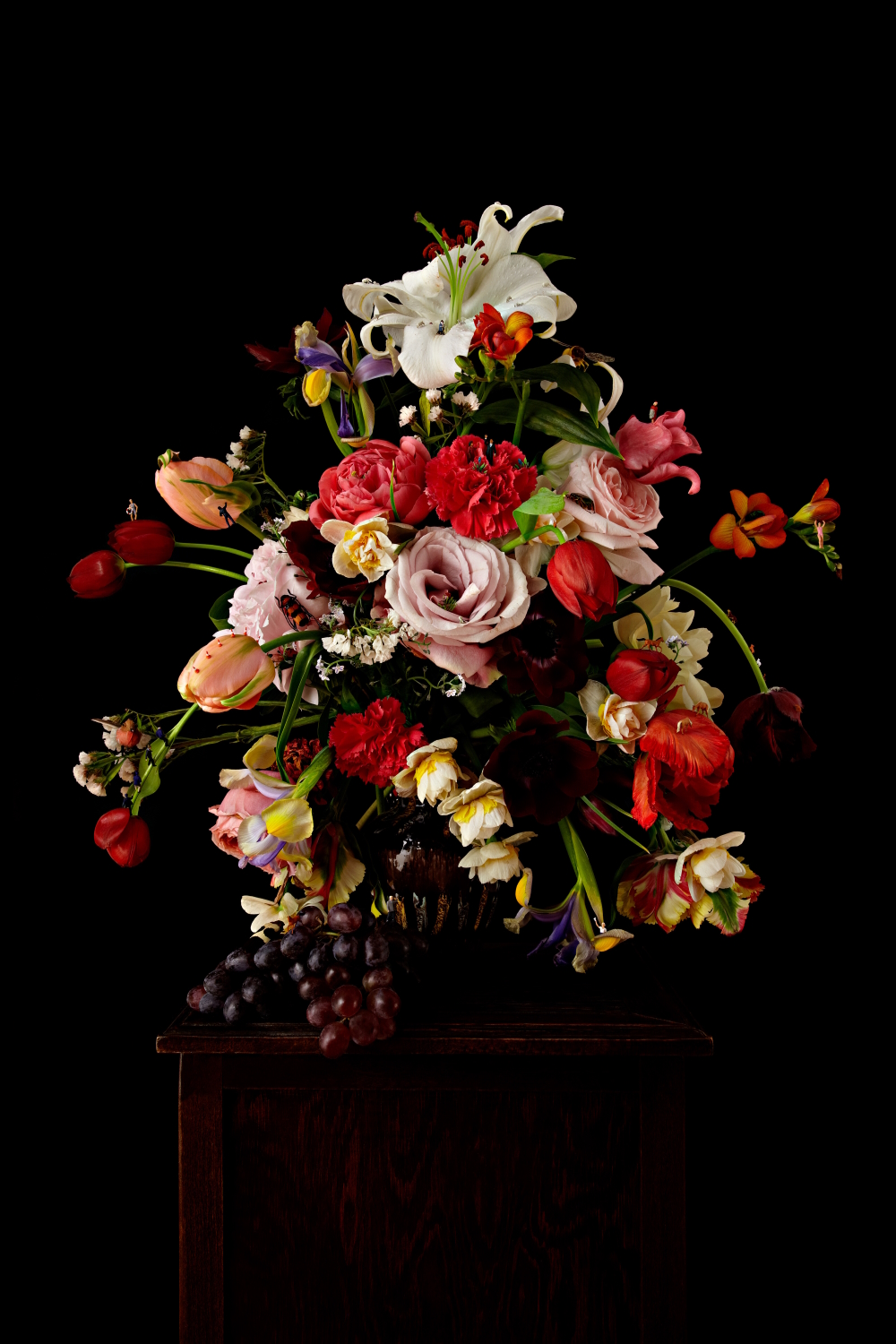Rebecca Louise Law
high-profile sculptural installation artist using natural materials
GB
„Flower skies“. „Flower cave“. „Deconstructed gardens“. „Floral magic“. Media's descriptions regarding „the transformation of space into colourful universes“ (domaine-chaumont.fr) vary. Fact is instead: for something like this becoming possible the most elements used is over one million dried flowers! They are hand tied on thin copper wire hanging from the ceiling. One can navigate through these cascading chandeliers of either monochrome or multicolored preserved flowers while enjoying the sight and smell. Flower power is the signature of a British lady who not only approaches her monumental installations as a painter, but paints really too, works with wood and glass, in print, pottery, weaving and more. The breathtaking, lush output is shown in exhibitions worldwide – be it in galleries, museums or even churches – and from Windsor Castle (UK) to Times Square (Viacom Building) in New York. Remarkable as well as representative for her artwork that „should open humanity’s eyes for valuing what is given“ is this poetic quote: „A dried flower holds time, a fresh flower holds a moment!“
Rebecca Louise Law
high-profile sculptural installation artist using natural materials
GB

A huge field of daisies with thousands of these tiny flowers as far as the eye could see: this unforgettable sight in childhood days culminated later for the then adult woman in the idea „to create that momentum for others to enjoy“. In these words Rebecca Louise Law reminds of the very first and basic intentions regarding her unique artworks. That the immersive installations are created with natural materials – flowers especially – comes as no surprise if you know her family roots. Rebecca Louise Law (* 1980) was raised in the English countryside outside Cambridge. Her father worked as a gardener, her mother was a teacher of rural science. Both of them dried flowers in the attic and arranged the preserved materials in framed pictures for decorating the walls. The grandma, being an artist, made floral paintings. A background like this including her aunt, an art teacher, one can call predestination for a good reason – at least in that specific case.
After graduating high school Rebecca Louise Law studied fine art at Newcastle’s School of Arts and Cultures. Already prior to concluding her assigment she created large scale paintings up to the point where these were difficult to move and transport. Switching to smaller and lighter formats was an obvious choice. “By breaking down the flowers and preserving each head as an element of colour“, she writes on her website, „I settled on swapping my paints for flowers. Flowers became a three-dimensional palette that allowed me to paint my expressions of nature in the air.”
The work materials for the first installations that were created during her Bachelor of Fine Arts in 2003 originated from a field that her father had ordered. The titles of that serie refer to what was planted there: ‚Dahlia‘, ‚Dahlia Sink‘ and ‚Dahlia Mirror‘.
A training in floral design at the prestigious McQueens Flowers in London where she rose to senior designer conveyed the necessary knowledge for what the lover of Dutch masters like Ambrosius Bosschaert (1573-1621) and Jan Davidszoon de Heem (1606-1684) became world-famous for: the combination of art with floristiry. But that’s not all. „My art practice does not only voice the beauty of the world through nature, but also encourages the audience to open their eyes and value the environment“, she’s quoted on lampoonmagazine.com. More on this topic Rebecca Louise Law adds on her website: “The convenience of consumerism has made everything too easy and too fast. The lack of attention to detail and little understanding of where things come from made me want to focus the viewers' attention back to nature. Flowers are my paint and I work with space as my canvas, but as you enter any installation you are taken back to nature’s divine beauty. The human soul needs nature and time to appreciate all that the earth provides.“
“The beautiful diversity of flower form, colour and texture is the medium with which Law artfully creates her sculptures and installations“, Richard Barley as director of Royal Botanic Gardens in Kew/London said on the occasion of one of her exhibitions: „She presents the viewer with a new lens through which to consider the quandaries that continue to intrigue the world’s greatest plant scientists.”
Since 2003 Mrs. Law has been collecting every flower and every remnant of dust left by flowers. She now has a collection of over one million preserved flowers exhibiting in the US, 250.000 flowers exhibiting in Asia and Australia and a collection of over 500.000 flowers exhibiting in Europe. This body of material keeps growing and with each new exhibition an extra layer of flowers is added to the existing material. Any dust left after installing an artwork is swept up, archived and encased in glass frames.
The evolution of Law’s artistic practice is documented in the richly illustrated hardcover „Life in Death“.
Rebecca Louise Law lives in an old countryhouse near the mountainous region of Snowdonia in northwestern Wales (Great Britain).
Interview March 2023
'Installation-painting' with flowers: to focus viewers‘ attention back to nature’s divine beauty
INTUITION/IMAGINATION
How does intuition present itself to you – in form of a suspicious impression, a spontaneous visualisation or whatever - maybe in dreams?
I dream every artwork. I trust my intuition. Sometimes I forget to listen to it, this is one area in my life that I am working at.
Will any ideas be written down immediately and archived?
I have many ongoing journals with thoughts.
I prefer to write about an installation. Putting the concept and place down in words helps me to visualise what I want the viewer to experience from the installation as a whole.
?: How do you come up with good or extraordinary ideas?
An education in Fine Art teaches you to break the boundaries. I was educated to never find affirmation in opinion but to communicate your beliefs through art. Value the earth and each other. This concept continues…
?: Do you feel that new creative ideas come as a whole or do you get like a little seed of inspiration that evolves into something else and has to be realized by endless trials and errors in form of constant developments up until the final result?
Every installation is a continuation of the last. Each new space and place brings education, I am continually learning and developing.
What if there is a deadline, but no intuition? Does the first fuel the latter maybe?
This never happens. But if I have to make too many compromises, I can feel like I have failed the artwork. This often is never very obvious to the viewer; I will always work as hard as possible with what I am given.
INSPIRATION
What inspires you and how do you stimulate this special form of imaginativeness?
Being in nature. Connecting to the sky, the sea and the land.
?: How do you filter between ideas worthwhile pursuing and bad ones that you just let go of?
I look at the heart of the artwork. If the intention is purely decorative and commercial this devalues the concept. I have learnt this the hard way.
Has it to appeal to you primarily or is its commercial potential an essential factor?
People and place need to be valued if this is compromised then the project will not appeal to me. Commercial potential is not a factor.
Do you revisit old ideas or check what colleagues/competitors are up to at times?
I revisit old ideas that have not been realised. My inspiration comes from nature rather than people, I am terrible at researching current trends but I love to explore galleries and museums when I get the chance.
CREATIVITY
Which time/place/environment suits your creative work process the best (tranquillity or pressure) and which path do you take from theory/idea to creation?
A tranquil place to realise the artwork through supporting works then transforms into pressure and deadlines of an installation. I have a bit of both worlds and if I’m in one too long it’s harder to transition to the other. I love to transfer my thinking and concepts on to canvas, sketches, writings and works in ceramics. The installations feel stronger if you can see my thoughts behind them.
What is better in the realization process: speed and force creativity i.e. grasp the magic of the moment, or a slow, ripening process for implementation/elaboration?
Both. It is good to have time to progress, if you continually work under pressure the work struggles to develop and move forwards. I love forcing myself to stop and sit in the stillness. However when I create an installation, after weeks of intense pressure there is a moment just before completion that can be euphoric.
?: Do you have any specific strategies you use when you are feeling stuck creatively?
I don’t create when I’m unhappy or exhausted and I have learnt to leave it, I distract myself with something else (nowadays this is often gardening) and I return to the work when I’m in a more positive state of mind.
How important are self-doubt and criticism (by others) during such a process i.e. is it better to be creative on your own, only trust your own instincts, or in a team?
I trust my own instincts, but I have an incredible team that listens and responds wisely. I often struggle with logistics in admin. Creatively I will question everything I do, I am probably my own worst critic.
Should a creative always remain true to him-/herself including taking risks & going against the flow or must one, for reasons of (commercial) survival, make concessions to the demands of the market, the wishes of clients and the audience’s expectations?
If you can survive without any commercial compromises, then you should try and stay as loyal as possible to your own concepts.
?: How is innovation still possible if one has established a distinctive style and, just in case, is it good to be ahead of one’s time even one hazards not being understood?
I believe you can never fully develop a concept. You will always be learning and developing. A lifetime is not long enough.
When does the time come to end the creative process, to be content and set the final result free - or is it work-in-progress with an endless possibility of improvement?
I think if you believe in something enough, you will not let go. The body and mind will have to fail you for your work to stop.
?: In case of failure or - worse - a creativity crisis how do you get out of such a hole?
It is ok to take a break. I believe that art for an artist is the way they communicate. They will always communicate for as long as they are able despite outside opinions.
SUCCESS
Should/can one resist the temptation to recycle a ‘formula’ one’s successful with?
You should always allow time for your art to grow. Personally I lose interest in repetition without development and I believe the viewer does too.
?: Is it desirable to create the ultimate/timeless work, but doesn’t “top of the ladder” bring up the question of “what’s next?” i.e. isn’t such a personal peak “the end”?
I’ve reached a personal peak many times and I feel so grateful for each place that this has happened. With age I feel the weight of responsibility has changed, there is an urge to share knowledge and delve into more serious conversations. Sustainability has always been at the heart of my artworks and valuing what the earth provides. I also value human beings and I strive to understand them. The one most valuable lesson I’ve learnt recently is to give people time. The community participation has been beautiful, many groups have formed and remain today. Looking after this earth and each other is essential for our soul and survival.
MY FAVORITE WORK:
I’m most proud of 'The Womb' - an installation I made at The Fredrick Meijer Gardens & Sculpture Park in Grand Rapids Township (Michigan, US). I explored 'The Womb' as a vessel. The intimacy of this installation was extremely powerful. It opened up a dialogue about our incredible human relationship with nature and many painful associations with the womb were sensitively given a place for a time.
